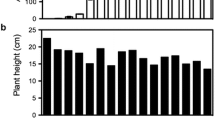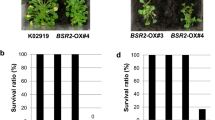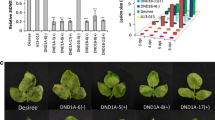Abstract
Tomato is one of the most important crop plants; however, attacks by pathogens can cause serious losses in production. In this report, we explore the potential of using the Arabidopsis thionin (Thi2.1) gene to genetically engineer enhanced resistance to multiple diseases in tomato. Potential thionin toxicity in fruits was negated by the use of a fruit-inactive promoter to drive the Thi2.1 gene. In transgenic lines containing RB7/Thi2.1, constitutive Thi2.1 expression was detected in roots and incidentally in leaves, but not in fruits. Disease assays revealed that the transgenic lines that were tested conferred significant levels of enhanced resistance to bacterial wilt (BW) and Fusarium wilt (FW). Further studies indicated that BW disease progression in transgenic lines was delayed by a systemic suppression of bacterial multiplication. By adopting a safe genetic engineering strategy, the present investigation is another step forward demonstrating thionin practicality in crop protection.






Similar content being viewed by others
References
Bohlmann H (1994) The role of thionins in plant protection. Crit Rev Plant Sci 13:1–6
Bohlmann H, Clausen S, Behnke S, Giese H, Hiller C, Schrader G, Barkholt V, Apel K (1988) Leaf-thionins of barley—a novel class of cell wall proteins toxic to plant-pathogenic fungi and possibly involved in the defense mechanism of plants. EMBO J 7:1559–1565
Bohlmann H, Vignutelli A, Hilpert B, Miersch O, Wasternack C, Apel K (1998) Wounding and chemicals induce expression of the Arabidopsis thaliana gene Thi2.1, encoding a fungal defense thionin, via the octadecanoid pathway. FEBS Lett 437:281–286
Bussing A, Stein GM, Wagner M, Wagner B, Schaller G, Pfuller U, Schietzel M (1999) Accidental cell death and generation of reactive oxygen intermediates in human lymphocytes induced by thionins from Viscum album L. Eur J Biochem 262:79–87
Carmona MJ, Molina A, Fernandez JA, Lopez-Fando JJ, Garcia-Olmedo F (1993) Expression of the alpha-thionin gene from barley in tobacco confers enhanced resistance to bacterial pathogens. Plant J 3:457–462
Conkling M, Cheng C-L, Yamamoto Y, Goodman H (1990) Isolation of transcriptionally regulated root-specific genes from tobacco. Plant Physiol 93:1203–1211
Crill P, Strobel J, Burgis D, Bryan H, John C, Everett P, Bartz J, Hayslip N, Deen W (1971) Florida MH-1, Florida’s first machine harvest fresh market tomato. Agricultural Experiment Station, University of Florida, p 12, Circular S-212
Deslandes L, Olivier J, Theulieres F, Hirsch J, Feng DX, Bittner-Eddy P, Beynon J, Marco Y (2002) Resistance to Ralstonia solanacearum in Arabidopsis thaliana is conferred by the recessive RRS1-R gene, a member of a novel family of resistance genes. Proc Natl Acad Sci USA 99:2404–2409
Epple P, Apel K, Bohlmann H (1997) Overexpression of an endogenous thionin enhances resistance of Arabidopsis against Fusarium oxysporum. Plant Cell 9:509–520
Epple P, Vignutelli A, Apel K, Bohlmann H (1998) Differential induction of the Arabidopsis thaliana Thi2.1 gene by Fusarium oxysporum f. sp. matthiolae. Mol Plant Microbe Interact 11:523–239
Fernandez de Caleya R, Gonzalez-Pascual B, Garcia-Olmedo F, Carbonero P (1972) Susceptibility of phytopathogenic bacteria to wheat purothionins in vitro. Appl Microbiol 23:998–1000
Hayward A (1991) Biology and epidemiology of bacterial wilt caused by Pseudomonas solanacearum. Annu Rev Phytopathol 29:65–87
Hemming MN, Basuki S, McGrath DJ, Carroll BJ, Jones DA (2004) Fine mapping of the tomato I-3 gene for fusarium wilt resistance and elimination of a co-segregating resistance gene analogue as a candidate for I-3. Theor Appl Genet (in press)
Holtorf S, Ludwig-Muller J, Apel K, Bohlmann H (1998) High-level expression of a viscotoxin in Arabidopsis thaliana gives enhanced resistance against Plasmodiophora brassicae. Plant Mol Biol 36:673–680
Hsieh TH, Lee JT, Charng YY, Chan MT (2002a) Tomato plants ectopically expressing Arabidopsis CBF1 show enhanced resistance to water deficit stress. Plant Physiol 130:618–626
Hsieh TH, Lee JT, Yang PT, Chiu LH, Charng YY, Wang YC, Chan MT (2002b) Heterology expression of the Arabidopsis C-repeat/dehydration response element binding factor 1 gene confers elevated tolerance to chilling and oxidative stresses in transgenic tomato. Plant Physiol 129:1086–1094
Huang Q, Allen C (2000) Polygalacturonases are required for rapid colonization and full virulence of Ralstonia solanacearum on tomato plants. Physiol Mol Plant Pathol 57:77–83
Lee T, Coyne D, Clemente T, Mitra A (2002) Partial resistance to bacterial wilt in transgenic tomato plants expressing antibacterial Lactoferrin gene. J Am Soc Hortic Sci 127:158–164
Lee J-T, Prasad V, Yang P-T, Wu J-F, Ho DT-H, Charng Y-Y, Chan M-T (2003) Expression of Arabidopsis CBF1 regulated by an ABA/stress inducible promoter in transgenic tomato confers stress tolerance without affecting yield. Plant Cell Environ 26:1181–1190
Li L, Steffens J (2002) Overexpression of polyphenol oxidase in transgenic tomato plants results in enhanced bacterial disease resistance. Planta 215:239–247
Lin W-C, Lu C-F, Wu J-W, Cheng M-L, Lin Y-M, Yang N-S, Black L, Green SK, Wang J-F, Cheng C-P (2004) Transgenic tomato plants expressing the Arabidopsis NPR1 gene confer enhanced resistance to a spectrum of fungal and bacterial diseases. Transgenic Res 13:(in press)
Molina A, Ahl-Goy P, Fraile A, Sanchez-Monge R, Garcia-Olmedo F (1993) Inhibition of bacterial and fungal plant pathogens by thionins of types I and II. Plant Sci 92:169–177
Robison M, Shah S, Tamot B, Pauls K, Moffatt B, Glick B (2001) Reduced symptoms of Verticillium wilt in transgenic tomato expressing a bacterial ACC deaminase. Mol Plant Pathol 2:135–145
Rommens CM, Kishore GM (2000) Exploiting the full potential of disease-resistance genes for agricultural use. Curr Opin Biotechnol 11:120–125
Tabaeizadeh Z, Agharbaoui Z, Harrak H, Poysa V (1999) Transgenic tomato plants expressing a Lycopersicon chilense chitinase gene demonstrate improved resistance to Verticillium dahliae race 2. Plant Cell Rep 19:197–202
Terras FRG, Eggermont K, Kovaleva V, Raikhel NV, Osborn RW, Kester A, Rees SB, Torrekens S, Leuven FV, Vanderleyden J, Cammue BPA, Broekaert WF (1995) Small cysteine-rich antifungal proteins from radish: their role in host defense. Plant Cell 7:573–588
Wang JF, Lin CH (2003) Colonization capacity of Ralstonia solanacearum tomato strains differing in aggressiveness on tomatoes and weeds. In: Allen CPP, Hayward AC (eds) Bacterial wilt: the disease and the Ralstonia solanaceraum species complex. APS, St Paul (in press)
Wang J, Hanson P, Barnes J (1998) Worldwide evaluation of an international set of resistance sources to bacterial wilt in tomato. In: Prior P, Allen C, Elphinstone J (eds) Bacterial wilt disease. Molecular and ecological aspects. Springer, Berlin Heidelberg New York, pp 269–275
Wang JF, Olivier J, Thoquet P, Mangin B, Sauviac L, Grimsley NH (2000) Resistance of tomato line Hawaii7996 to Ralstonia solanacearum Pss4 in Taiwan is controlled mainly by a major strain-specific locus. Mol Plant Microbe Interact 13:6–13
Yamamoto Y, Taylor C, Acedo G, Cheng C, Conkling M (1991) Characterization of cis-acting sequences regulating root-specific gene expression in tobacco. Plant Cell 3:371–382
Acknowledgements
We are grateful to The Institute of Molecular Biology for providing experimental equipments and facility and AVRDC—The World Vegetable Center for their technical assistance. We also thank Dr. Kenrick Deen for his critical review of this manuscript. This work was supported by a grant from Academia Sinica and grant NSC-92-2317-B-001-037 from the National Science Council of the Republic of China. This work was carried out in compliance with the current laws governing genetic experimentation in Taiwan, the Republic of China. Yuan-Li Chan and Venkatesh Prasad contributed equally to this work. Chiu-Ping Cheng and Ming-Tsair Chan also contributed equally to this work.
Author information
Authors and Affiliations
Corresponding authors
Rights and permissions
About this article
Cite this article
Chan, YL., Prasad, V., Sanjaya, . et al. Transgenic tomato plants expressing an Arabidopsis thionin (Thi2.1) driven by fruit-inactive promoter battle against phytopathogenic attack. Planta 221, 386–393 (2005). https://doi.org/10.1007/s00425-004-1459-3
Received:
Accepted:
Published:
Issue Date:
DOI: https://doi.org/10.1007/s00425-004-1459-3




